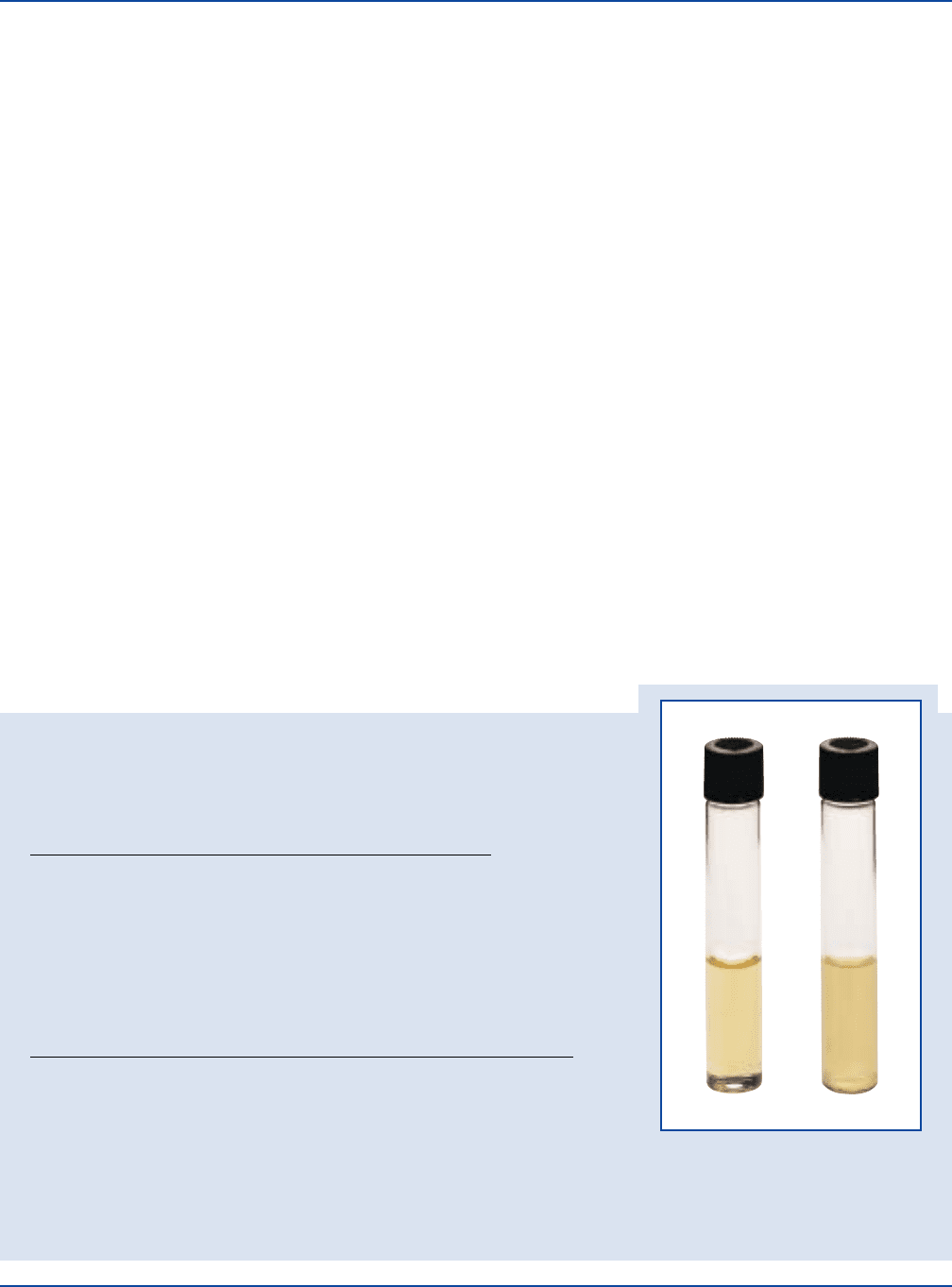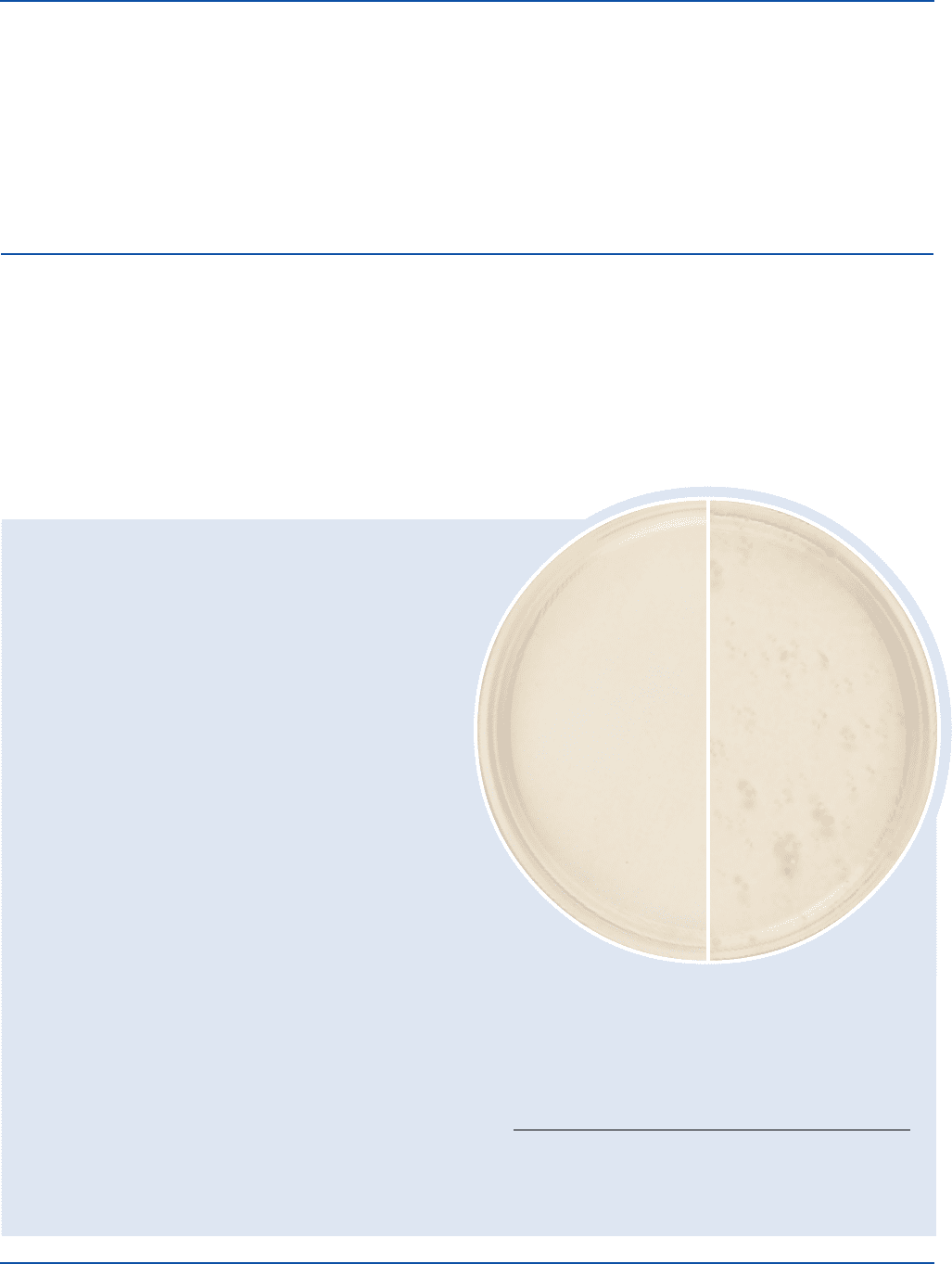BD Diagnostic Systems (publ.). Difco Manual (Manual of Microbiological Culture)
Подождите немного. Документ загружается.


526 The Difco Manual
TSA is recommended in multiple water and wastewater applications.
4
Tryptic Soy Agar conforms to the formula specified by US
Pharmacopeia for use in Microbiological Tests
5
, Antimicrobial
Preservatives-Effectiveness and Microbial Limits Test.
Clinically, Tryptic Soy Agar is used in the differentiation of
Haemophilus species, because it does not contain the X and V
factors required for Haemophilus growth. With the addition of
Differentiation Disks V, X and VX, Haemophilus growth can be
observed around the appropriate disk.
Tryptic Soy Agar is a nutritious base to which a variety of supplements
can be added. Addition of 5% sterile, defibrinated sheep, horse or
rabbit blood provides an excellent general purpose medium that
allows the growth of yeast species, staphylococci, enterococci and
gram-negative bacilli.
6
TSA blood agars may be used to determine
hemolytic reactions of bacteria. TSA supplemented with lecithin and
polysorbate 80 is the formula for Microbial Content Test Agar
(also known as TSALT) used in environmental monitoring.
7
For
the examination of foods, Tryptic Soy Agar is supplemented
with 3% NaCl for the isolation of Vibrio species and halophilic
microorganisms.
8
Tryptic Soy Agar supplemented with 0.6% yeast
extract is used for the isolation of Listeria monocytogenes and
cultivation of a wide variety of heterotrophic microorganisms.
8
Addition of colistin and nalidixic acid to TSA is used for the
selective isolation of gram-positive cocci.
9
Gunn et al.
10
used
trimethoprim and sulfamethoxazole (SxT) supplementation to inhibit
normal flora on throat specimens, allowing Groups A and B
streptococci to grow well. Addition of iron salt and sodium thiosulfate
to TSA aids in the identification of non-fermentating gram-negative
bacilli, and with nitro blue tetrazolium (0.5% aqueous solution)
allows for the selective isolation of Corynebacterium diphtheriae.
11
Chocolate Agar for culturing Haemophilus influenzae and related
organisms may be prepared by adding 1% Hemoglobin and
Supplement B to Tryptic Soy Agar.
The methodologies for multiple applications using Tryptic Soy Agar
are outlined in the references.
Principles of the Procedure
Tryptone and Soytone provide nitrogen, vitamins and minerals. The
natural sugars from the soybean promote bacterial growth. Sodium
Chloride maintains the osmotic balance of the medium. Bacto Agar is
a solidifying agent.
Formula
Tryptic Soy Agar
Formula Per Liter
Bacto Tryptone . . . . . . . . . . . . . . . . . . . . . . . . . . . . . . . . . . 15 g
Pancreatic Digest of Casein
Bacto Soytone . . . . . . . . . . . . . . . . . . . . . . . . . . . . . . . . . . . . 5 g
Papaic Digest of Soybean Meal
Sodium Chloride . . . . . . . . . . . . . . . . . . . . . . . . . . . . . . . . . . 5 g
Bacto Agar . . . . . . . . . . . . . . . . . . . . . . . . . . . . . . . . . . . . . 15 g
Final pH 7.3 ± 0.2 at 25°C
Precautions
1. For Laboratory Use.
2. Follow proper established laboratory procedure in handling and
disposing of infectious materials.
Storage
Store the dehydrated medium below 30°C. The dehydrated medium is
very hygroscopic. Keep container tightly closed.
Expiration Date
The expiration date applies to the product in its intact container
when stored as directed. Do not use a product if it fails to meet
specifications for identity and performance.
Procedure
Materials Provided
Tryptic Soy Agar
Materials Required But Not Provided
Glassware
Autoclave
Incubator (35°C)
Waterbath (45-50°C) (optional)
Defibrinated blood (optional)
Method of Preparation
1. Suspend 40 grams in 1 liter distilled or deionized water.
2. Heat to boiling to dissolve completely.
3. Autoclave at 121°C for 15 minutes. Cool to room temperature.
4. OPTIONAL: To prepare blood agar, aseptically add 5% sterile
defibrinated blood to the medium at 45-50°C. Mix well.
Specimen Collection and Preparation
Refer to appropriate references for specimen collection and preparation.
Test Procedure
See appropriate references for specific procedures.
Results
Refer to appropriate references and procedures for results.
References
1. Leavitt, J. M., I. J. Naidorf and P. Shugaevsky. 1955. The
undetected anaerobe in endodontics; a sensitive medium for
detection of both aerobes and anaerobes. The NY J. Dentist.
25:377-382.
2. Swanson, K. J., F. F. Busta, E. H. Peterson and M. G. Johnson.
1992. Colony Count Methods, p.75-95. In C. Vanderzant,
and D. F. Spittstoesser (ed.), Compendium of methods for the
microbiological examination of foods, 3rd ed. American Public
Health Association, Washington, D.C.
3. Curry, A. S., G. G. Joyce, and G. N. McEwen, Jr. 1993. CTFA
Microbiology guidelines. The Cosmetic, Toiletry, and Fragrance
Association, Inc., Washington, D.C.
4. Greenberg, A. E., L. S. Clesceri, and A. D. Eaton (ed). 1995.
Standard methods for the examination of water and wastewater,
19th ed. American Public Health Association, Washington, D.C.
Tryptic Soy Agar Section II

The Difco Manual 527
5. The United States Pharmacopeia. 1995. Microbiological tests,
p. 1681-1686. The United States pharmacopeia, 23rd ed. United
States Pharmacopeial Convention, Rockville, MD.
6. Baron, E. J., L. R. Peterson, and S. M. Finegold. 1994.
Etiological agents recovered from clinical material, p. 244. Bailey
& Scott’s Diagnostic Microbiology, 9th ed. Mosby-Year Book, Inc.,
St. Louis, MO.
7. Orth, D. S. 1993. Handbook of cosmetic microbiology. Marcel
Dekker, Inc., New York, NY.
8. Harmon, S. M., D. A. Kautter, D. A. Golden, and E. J.
Rhodehamel. 1995. Bacteriological analytical manual, 8th ed.
AOAC International, Arlington, VA.
9. Ellner, P. 1966. J. of Clin. Pathol. 45:502-504.
Section II Tryptic Soy Broth & Tryptic Soy Broth w/o Dextrose
10. Gunn, B. A., D. K. Ohashi, C. A. Gaydos, and E. S. Holt. 1977.
Selective and enhanced recovery of group A and B streptococci
from throat cultures with sheep blood containing sulfamethoxazole
and trimethoprim. J. Clin. Microbiol. 5:650-655.
11. MacFaddin, J. D. 1985. Media for isolation-cultivation-
identification- maintenance of medical bacteria, vol. 1, p. 794-802.
Williams & Wilkins, Baltimore, MD.
Packaging
Tryptic Soy Agar 100 g 0369-15
500 g 0369-17
2 kg 0369-07
10 kg 0369-08
Bacto
®
Tryptic Soy Broth
Bacto Tryptic Soy Broth w/o Dextrose
User Quality Control
Identity Specifications
Tryptic Soy Broth
Dehydrated Appearance: Light beige, free-flowing, homogeneous.
Solution: 3.0% solution, soluble in distilled or
deionized water. Solution is light
amber, clear.
Prepared Medium: Light amber, clear.
Reaction of 3.0%
Solution at 25°C: pH 7.3 ± 0.2
Tryptic Soy Broth w/o Dextrose
Dehydrated Appearance: Light beige, free-flowing, homogeneous.
Solution: 2.75% solution, soluble in distilled or
deionized water; light amber, clear to
very slightly opalescent.
Prepared Medium: Light amber, clear to very slightly
opalescent.
Reaction of 2.75%
Solution at 25°C: pH 7.3 ± 0.2
Intended Use
Bacto Tryptic Soy Broth is used for cultivating a wide variety of
microorganisms. Tryptic Soy Broth conforms with the formula
specified in the US Pharmacopeia XXIII (USP)
1
and the Code of
Federal Regulations (21 CFR)
2
for sterility testing of pharmaceutical
products, biologics and devices.
Bacto Tryptic Soy Broth w/o Dextrose, a low carbohydrate formula-
tion of Tryptic Soy Broth, is used for cultivating fastidious and
non-fastidious microorganisms.
Also Known As
Tryptic Soy Broth is commonly referred to as Soybean-Casein Digest
Medium, USP, and Fluid Soybean-Casein Digest Medium; it is
abbreviated as TSB.
Summary and Explanation
Tryptic Soy Broth is a general purpose medium used for isolating
fastidious and non-fastidious microorganisms. Tryptic Soy Broth was
originally developed for use without blood in determining the
effectiveness of sulfonamides against pneumococci and other
organisms.
3
Tryptic Soy Broth is often used to support growth of
non-typical isolates such as Brucella.
4
Clostridia and non-sporulating
anaerobes grow luxuriantly in this broth when incubated under
anaerobic conditions. Garrison
5
and Hedgecock
6
used TSB to support
growth of Histoplasma capsulatum. Mashimo and Ellison
7
supplemented this medium with agar to enhance growth of anaerobic
organisms. With the addition of 6.5% NaCl, TSB can be used for the
selective growth of group D streptococci.
Tryptic Soy Broth was chosen by the USDA Animal and Plant Health
Inspection Service for detecting viable bacteria in live vaccines.
9
It is
used in the coliphage detection procedure, a proposed methodology in
Standard Methods for the Examination of Water and Wastewater.
10
TSB
is recommended for testing bacterial contaminants in cosmetics
11
and
complies with established standards
12,13
in the food industry.
TSB is recommended by the National Committee for Clinical Laboratory
Standards (NCCLS)
14
for inoculum preparation when performing the
disk diffusion sensitivity test, also known as the Kirby-Bauer method.
The rich nutritional base of Tryptic Soy Broth is often modified to
provide varying growth environments. With the addition of
1% Supplement B, TSB will support growth of Neisseria, Haemophilus
influenzae and other related organisms. The medium is used as an
enrichment broth in clinical applications and is an excellent blood
culture medium when supplemented with SPS and CO
2
.
15
Tryptic Soy Broth w/o Dextrose, a modification of TSB, is a basal
medium to which carbohydrates may be added for use in fermentation
studies. Agar may be added (0.5-1.0 grams/liter) to enhance anaerobic
growth.
16
Phenol red and other indicators may also be added.
continued on following page

528 The Difco Manual
Principles of the Procedure
Tryptone and Soytone are nitrogen sources in Tryptic Soy Broth and
Tryptic Soy Broth w/o Dextrose. Dextrose is a carbon energy source
that facilitates organism growth. Sodium chloride maintains osmotic
balance, while dipotassium phosphate is a buffering agent.
Dextrose is omitted from the formula for Tryptic Soy Broth w/o
Dextrose to permit use of the medium in fermentation studies. The
carbohydrate concentration used most frequently in fermentation
reactions is 0.5% or 1%.
Formula
Tryptic Soy Broth
Formula Per Liter
Bacto Tryptone . . . . . . . . . . . . . . . . . . . . . . . . . . . . . . . . . . 17 g
Bacto Soytone . . . . . . . . . . . . . . . . . . . . . . . . . . . . . . . . . . . . 3 g
Bacto Dextrose . . . . . . . . . . . . . . . . . . . . . . . . . . . . . . . . . . 2.5 g
Sodium Chloride . . . . . . . . . . . . . . . . . . . . . . . . . . . . . . . . . . 5 g
Dipotassium Phosphate . . . . . . . . . . . . . . . . . . . . . . . . . . . 2.5 g
Final pH 7.3 ± 0.2 at 25°C
Tryptic Soy Broth w/o Dextrose
Formula Per Liter
Bacto Tryptone . . . . . . . . . . . . . . . . . . . . . . . . . . . . . . . . . . 17 g
Bacto Soyton . . . . . . . . . . . . . . . . . . . . . . . . . . . . . . . . . . . . . 3 g
Sodium Chloride . . . . . . . . . . . . . . . . . . . . . . . . . . . . . . . . . . 5 g
Dipostassium Phosphate . . . . . . . . . . . . . . . . . . . . . . . . . . . 2.5 g
Final pH 7.3 ± 0.2 at 25°C
Precautions
1. For Laboratory Use.
2. Follow proper established laboratory procedures in handling and
disposing of infectious materials.
Storage
Store the dehydrated medium below 30°C. The dehydrated medium is
very hygroscopic. Keep container tightly closed.
Expiration Date
The expiration date applies to the product in its intact container when
stored as directed. Do not use a product if it fails to meet specifications
for identity and performance.
Procedure
Materials Provided
Tryptic Soy Broth
Tryptic Soy Broth w/o Dextrose
Materials Required But Not Provided
Glassware
Autoclave
Incubator (35°C)
Sterile tubes
Method of Preparation
1. Suspend the medium in 1 liter distilled or deionized water:
Tryptic Soy Broth - 30 grams;
Tryptic Soy Broth w/o Dextrose - 27.5 grams.
2. Dispense as desired.
3. Autoclave at 121°C for 15 minutes. Cool to room temperature.
User Quality Control Cont.
Cultural Response
Prepare Tryptic Soy Broth or Tryptic Soy Broth w/o Dextrose per label directions.
Inoculate medium and incubate at 35 ± 2°C for 18-48 hours or up to 76 hours if necessary.
INOCULUM
ORGANISM ATCC
®
CFU GROWTH
Neisseria meningitidis 13090* 10-100 fair to good
Staphylococcus epidermidis 12228* 10-100 good
Streptococcus pneumoniae 6305 10-100 good
Streptococcus pyogenes 19615* 10-100 good
USP and EP Growth Promotion
1
Prepare Tryptic Soy Broth per label directions. Inoculate medium and
incubate at the temperature specified for up to 7 days.
Tryptic Soy Broth & Tryptic Soy Broth w/o Dextrose Section II
Staphylococcus
epidermidis
ATCC
®
12228
Uninoculated
tube
INOCULUM INCUBATION
ORGANISM ATCC
®
CFU TEMPERATURE RECOVERY
Bacillus subtilis 6633 10-100 20-25°C growth must be evident
Candida albicans 2091 10-100 20-25°C growth must be evident
Candida albicans 10231 10-100 20-25°C growth must be evident
Clostridium sporogenes 19404 10-100 30-35°C growth must be evident
Staphylococcus aureus 6538P 10-100 30-35°C growth must be evident
The cultures listed are the minimum that should be used for performance testing.
*These cultures are available as Bactrol
™
Disks and should be used as directed in
Bactrol Disks Technical Information.

The Difco Manual 529
Specimen Collection and Preparation
Obtain and process specimens according to the techniques and
procedures established by laboratory policy.
Test Procedure
Methodologies for the multiple applications using Tryptic Soy Broth
and Tryptic Soy Broth w/o Dextrose are outlined in the references.
Results
Refer to appropriate references and procedures for results.
References
1. United States Pharmacopeial Convention. 1995. The United
States pharmacopeia, 23rd ed. The United States Pharmacopeial
Convention, Rockville, MD.
2. Federal Register. 1992. General biological products standards.
Fed. Regist. 21:610.12.
3. McCullough, N. B. 1949. Laboratory tests in the diagnosis of
brucellosis. Amer. J. of Public Health 39:866-869.
4. Baron, E. J., L. R. Peterson, and S. M. Finegold. 1994.
Microorganisms encountered in the blood, p. 205. Bailey & Scott’s
diagnostic microbiology, 9th ed. Mosby-Year Book, Inc.,
St. Louis, MO.
5. Garrison, R. G. 1961. Studies of the respiratory activity of
Histoplasma capsulatum. J. of Infect. Dis. 108:120-124.
6. Hedgecock, L. W. 1971. Effect of vaccines prepared from
Histoplasma capsulatum and other yeast on experimental
tuberculosis. J. Bacteria. 82:115- 123.
7. Mashimo, P. A., and S. A. Ellison. 1959. Simple method for the
isolation of anaerobic oral vibrios. J. Bacteria. 78:636-639.
8. Sherman, J. M., and P. Stark. 1961. Streptococci which grow at
high temperatures. J. Bacteria. 22:275-285.
9. Federal Register. 1992. Detection of viable bacteria and fungi
except in live vaccine. Fed. Regist. 21:113.26.
10. Greenberg, A. E., L. S. Clesceri, and A. D. Eaton (eds). 1992.
Coliphage detection, 9,22-23. Standard methods for the
examination of water and wastewater, 18th ed. American Public
Health Association, Washington, D.C.
11. Curry, A. S., G. G. Joyce, and G. N. McEwen, Jr. 1993. CTFA
Microbiology guidelines. The Cosmetic, Toiletry, and Fragrance
Association, Inc., Washington, D.C.
12. Association of Official Analytical Chemists. 1995. Bacteriological
analytical manual, 8th ed. AOAC International, Gaithersburg, MD.
13. Cunnif, P. 1995. Official methods of analysis AOAC International,
16th ed. AOAC International, Arlington, VA.
14. National Committee for Clinical Laboratory Standards. 1994.
Performance standards for antimicrobial disk susceptibility tests,
M2-A5, vol. 13, no. 24. National Committee for Clinical
Laboratory Standards, Villanova, PA.
15. Isenberg, H. D. (ed.). 1992. Processing and interpretation of blood
cultures, p. 1.7.1-1.7.2. Clinical microbiology procedures hand-
book, vol. 1. American Society for Microbiology, Washington, D.C.
16. MacFaddin, J. D. 1985. Media for isolation-cultivation-
identification-maintenance of medical bacteria, p. 797, vol. 1.
Williams & Wilkins, Baltimore, MD.
Packaging
Tryptic Soy Broth 100 g 0370-15
500 g 0370-17
2 kg 0370-07
10 kg 0370-08
Tryptic Soy Broth w/o Dextrose 500 g 0862-17
10 kg 0862-08
Section II Tryptone Peptone
Bacto
®
Tryptone Peptone
Intended Use
Bacto Tryptone Peptone is used in preparing microbiological culture
media.
Also Known As
Tryptone Peptone is also referred to as Peptone C, Peptone 50 and
Tryptone T.
Summary and Explanation
Tryptone Peptone is a pancreatic digest of casein used as a nitrogen
source in culture media formulated for isolating and cultivating fas-
tidious and nonfastidious bacteria and fungi.
Tryptone Peptone was developed by Difco Laboratories while investi-
gating a peptone particularly suitable for the elaboration of indole by
bacteria. The high tryptophane content of Tryptone Peptone makes it
valuable for use in detecting indole production.
1,2,3
The absence of de-
tectable levels of carbohydrates in Tryptone Peptone makes it a suit-
able peptone in differentiating bacteria on the basis of their ability to
ferment various carbohydrates.
Several media containing Tryptone Peptone are specified in standard
methods
4,5,6,7
for multiple applications.
Principles of the Procedure
Tryptone Peptone is a pancreatic digest of casein especially rich in tryp-
tophane. Casein, a milk protein, is a rich source of amino acid nitrogen.
User Quality Control
Identity Specifications
Dehydrated Appearance: Light beige, free-flowing,
homogeneous powder.
Solution: 1%, 2% and 10% solutions are soluble
in distilled or deionized water:
1%-Very light to light amber, clear
without precipitate;
2%-Light to medium amber, clear
without precipitate;
10%-Medium to dark amber, clear to
slightly opalescent, may have a
slight precipitate.
Nitrogen
(Kjeldahl Method)
: 11.4-13.9%
Amino Nitrogen
(Modified Sorensen Method):
4.0-6.6%
Reaction of 2%
Solution at 25°C: pH 6.9-7.4
continued on following page

530 The Difco Manual
Typical Analysis
Physical Characteristics
Ash (%) 6.8 Loss on Drying (%) 3.7
Clarity, 1% Solution (NTU) 0.5 pH, 1% Solution 7.2
Filterability (g/cm
2
)1.3
Carbohydrate (%)
Total 7.7
Nitrogen Content (%)
Total Nitrogen 13.0 AN/TN 20.7 40.0
Amino Nitrogen 5.2
Amino Acids (%)
Alanine 2.86 Lysine 6.70
Arginine 3.03 Methionine 2.57
Aspartic Acid 6.11 Phenylalanine 3.71
Cystine 0.42 Proline 7.45
Glutamic Acid 17.05 Serine 4.29
Glycine 1.75 Threonine 3.58
Histidine 2.02 Tryptophan 0.71
Isoleucine 4.40 Tyrosine 1.42
Leucine 7.11 Valine 5.00
Inorganics (%)
Calcium 0.013 Phosphate 2.669
Chloride 0.186 Potassium 0.229
Cobalt <0.001 Sodium 2.631
Copper <0.001 Sulfate 0.241
Iron <0.001 Sulfur 0.740
Lead <0.001 Tin <0.001
Magnesium 0.017 Zinc 0.003
Manganese <0.001
Vitamins (µg/g)
Biotin 0.1 PABA 3.7
Choline
(as Choline Chloride)
350.0 Pantothenic Acid 5.3
Cyanocobalamin <0.1 Pyridoxine 0.6
Folic Acid 0.3 Riboflavin <0.1
Inositol 1400.0 Thiamine 0.4
Nicotinic Acid 97.8 Thymidine 93.4
Biological Testing (CFU/g)
Coliform negative
Salmonella negative
Spore Count 73
Standard Plate Count 870
Thermophile Count 8
The values presented are “typical”. This information is for broad
comparison use only and is not indicative of the makeup of any
particular lot of material. No guarantee is made, either expressed or
implied, that any specific lot of product will match the values presented.
Procedure
Materials Provided
Tryptone Peptone
Materials Required But Not Provided
Materials vary depending on the medium being prepared.
Method of Preparation
Refer to the final concentration of Tryptone Peptone in the formula of
the medium being prepared. Add Tryptone Peptone as required.
Specimen Collection and Preparation
Obtain and process specimens according to the techniques and
procedures established by laboratory policy.
Test Procedure
See appropriate references for specific procedures using Tryptone Pep-
tone.
Results
See appropriate references and procedures for results.
References
1. J. Bacteriol. 1933. 25:623.
2. Pure Culture Study of Bacteria. 1947. No. 3
3. Centr. Bakt. , I Abt. 1915. 76:1.
Tryptone Peptone Section II
User Quality Control cont.
Cultural Response
For each Test specified, prepare a Test Solution of Tryptone Peptone and, if necessary, adjust to pH 7.2-7.4; sterilize, inoculate and
incubate according to standard test procedure.
TEST TEST SOLUTION ORGANISM ATCC
®
INOCULUM RESULT
Fermentable Carbohydrates 2% Escherichia coli 25922* 1 drop, undiluted negative; red color
Indole Production 0.1% Escherichia coli 25922* 1 drop, undiluted positive; pink color on
Indole Test Strip
Acetylmethylcarbinol 0.1% w/ 0.5% Enterobacter aerogenes 13048* 1 drop, undiluted positive; pink color upon
Production dextrose adding reagents
Hydrogen Sulfide 1% Salmonella typhi 6539 1 drop, undiluted positive; brownish blackening
Production of H
2
S Test Strip
Growth Production 2% w/1.5% agar Escherichia coli 25922* 100-1,000 CFU good growth
and 0.5% NaCl
Growth Production 2% w/1.5% agar Staphylococcus aureus 25923* 100-1,000 CFU good growth
and 0.5% NaCl
The cultures listed are the minimum that should be used for performance testing.
*These cultures are available as Bactrol
TM
Disks and should be used as directed in Bactrol Disks Technical Information.

The Difco Manual 531
4. Vanderzant, C., and D. F. Splittstoesser (ed.). 1992. Compendium
of methods for the microbiological examination of food, 3rd ed.
American Public Health Association, Washington, D.C.
5. Association of Official Analytical Chemists. 1995. Bacteriological
analytical manual , 8th ed. AOAC International, Gaithersburg, MD.
6. Eaton, A. D., L. S. Clesceri, and A. E. Greenberg (ed.). 1995.
Standard methods for the examination of water and wastewater,
19th ed. American Public Health Association, Washington, D.C.
Section II Tryptone Glucose Extract Agar & m TGE Broth
7. Marshall, R. T. (ed.). 1993. Standard methods for the examination
of dairy products, 16th ed. American Public Health Association,
Washington, D.C.
Packaging
Tryptone Peptone 100 g 0123-15
500 g 0123-17
2 kg 0123-07
10 kg 0123-08
Pasturized
milk
Uninoculated
plate
Bacto
®
Tryptone Glucose Extract Agar
Bacto m TGE Broth
User Quality Control
Identity Specifications
Tryptone Glucose Extract Agar
Dehydrated Appearance: Light to medium tan, free-flowing,
homogeneous.
Solution: 2.4% solution, soluble in distilled or
deionized water on boiling. Solution
is light amber, clear to slightly
opalescent, no significant precipitate.
Prepared Medium: Light amber, clear to slightly
opalescent, no precipitate.
Reaction of 2.4%
Solution at 25°C: pH 7.0 ± 0.2
m TGE Broth
Dehydrated Appearance: Light tan, free-flowing, homogeneous.
Solution: 1.8% solution, soluble in distilled or
deionized water. Solution is medium amber,
clear to very slightly opalescent.
Prepared Medium: Medium amber, clear to very slightly opalescent.
Reaction of 1.8%
Solution at 25°C: pH 7.0 ± 0.2
Cultural Response
Tryptone Glucose Extract Agar
Prepare Tryptone Glucose Extract Agar per label directions in
parallel with a reference control. Inoculate with pasteurized
and raw milk samples using the pour plate technique and
incubate at 32 ± 1°C for 47-49 hours. Recovery of bacteria
from the milk samples should be comparable for both the test
and reference lots.
m TGE Broth
Prepare mTGE Broth per label directions. Inoculate using the
membrane filter technique and incubate in a humid atmosphere
at 35 ± 2°C for 18-24 hours.
ORGANISM ATCC
®
INOCULUM CFU GROWTH
Escherichia coli 25922* 100-1,000 good
Staphylococcus aureus 25923* 100-1,000 good
The cultures listed are the minimum that should be used for performance testing.
*These cultures are available as Bactrol
™
Disks and should be used as directed in Bactrol Disks Technical Information.
Intended Use
Bacto Tryptone Glucose Extract Agar is used for cultivating and
enumerating microorganisms in water and dairy products.
Bacto m TGE Broth is used for enumerating microorganisms by
membrane filtration.
Also Known As
Tryptone Glucose Extract Agar is also known as Yeast Dextrose Agar
and may be abbreviated as TGEA.
m TGE is an abbreviation for membrane Tryptone Glucose Extract.

532 The Difco Manual
Summary and Explanation
In the 1930’s, Bower and Hucker
1
developed a medium for detecting
bacteria in milk and other dairy products. Many investigators compared
the performance of Tryptone Glucose Skim Milk Agar to Nutrient Agar
for estimating bacteria in milk and other dairy products.
2,3,4
Prickett
5
used a glucose agar containing Tryptone to study thermophilic bacteria
in milk. This medium, described in Standard Methods of Milk Analysis
6
,
was prepared in the dehydrated form as Yeast Dextrose Agar. The
American Public Health Association (APHA) adopted Tryptone
Glucose Extract Agar for use in testing milk and dairy products in
1948.
7
For many years, Tryptone Glucose Extract Agar with added milk
remained the Standard Methods medium for dairy products
8
and was
also adopted for testing water.
9
Currently, the APHA specifies using
Tryptone Glucose Extract Agar for the heterotrophic plate count
procedure in testing bottled water.
10
m TGE Broth is a nonselective nutrient medium for the determination
of bacterial counts by the membrane filter method. The broth has the
same formulation as Tryptone Glucose Extract Agar, except that the broth
contains no agar and the ingredients are at twice the concentration.
Principles of the Procedure
Tryptone Glucose Extract Agar and m TGE Broth contain Beef Extract
and Tryptone as sources of carbon, nitrogen, vitamins and minerals.
Dextrose (Glucose) is a carbohydrate. Tryptone Glucose Extract Agar
contains Bacto Agar as a solidifying agent.
Formula
Tryptone Glucose Extract Agar
Formula Per Liter
Bacto Beef Extract . . . . . . . . . . . . . . . . . . . . . . . . . . . . . . . . 3 g
Bacto Tryptone . . . . . . . . . . . . . . . . . . . . . . . . . . . . . . . . . . . 5 g
Bacto Dextrose (Glucose) . . . . . . . . . . . . . . . . . . . . . . . . . . 1 g
Bacto Agar . . . . . . . . . . . . . . . . . . . . . . . . . . . . . . . . . . . . . 15 g
Final pH 7.0 ± 0.2 at 25°C
m TGE Broth
Formula Per Liter
Bacto Beef Extract . . . . . . . . . . . . . . . . . . . . . . . . . . . . . . . . 6 g
Bacto Tryptone . . . . . . . . . . . . . . . . . . . . . . . . . . . . . . . . . . 10 g
Bacto Dextrose . . . . . . . . . . . . . . . . . . . . . . . . . . . . . . . . . . . 2 g
Final pH 7.0 ± 0.2 at 25°C
Precautions
1. For Laboratory Use.
2. Follow proper established laboratory procedures in handling and
disposing of infectious materials.
Storage
Store the dehydrated medium below 30°C. The dehydrated medium is
very hygroscopic. Keep container tightly closed.
Expiration Date
The expiration date applies to the product in its intact container when
stored as directed. Do not use a product if it fails to meet specifications
for identity and performance.
Procedure
Materials Provided
Tryptone Glucose Extract Agar
m TGE Broth
Materials Required but not Provided
Glassware
Distilled or deionized water
Autoclave
Petri dishes (Tryptone Glucose Extract Agar)
Sterile membranes (m TGE Broth)
Filter apparatus (m TGE Broth)
Sterile absorbent pads (m TGE Broth)
Incubator (TGEA - 32 ± 1°C; mTGE Broth - 35°C)
Method of Preparation
Tryptone Glucose Extract Agar (TGEA)
1. Suspend 24 grams in 1 liter distilled or deionized water.
2. Heat to boiling to dissolve completely.
3. Autoclave at 121°C for 15 minutes.
m TGE Broth
1. Dissolve 18 grams in 1 liter distilled or deionized water.
2. Autoclave at 121°C for 15 minutes. Cool to room temperature.
Specimen Collection and Preparation
Collect samples in accordance with laboratory procedures.
10
Test Procedure
1. Use the appropriate culture method, as follows:
TGEA - pour plate method;
m TGE - membrane filtration.
2. Incubate the inoculated medium in a humid atmosphere, as follows:
TGEA - 32 ± 1°C for 47-49 hours;
m TGE - 35 ± 2°C for 18-24 hours.
Results
Count total colonies and record results.
Limitations of the Procedure
1. Since the nutritional requirements of organisms vary, some strains
may be encountered that fail to grow or grow poorly on this medium.
References
1. Bowers and Hucker. 1935. Tech. Bull. 228. NY State Agr. Exp. Sta.
2. Yale. 1938. Am. J. Pub. Health 28:148.
3. Proc. 36th Cong. Intern. Assoc. Ice Cream Manufacturers.
1936. 2:132.
4. Dennis and Weiser. 1937. J. Dairy Science 20:445.
5. Prickett. 1928. Tech. Bull. 147. NY State Agr. Exp. Sta.
6. Standard Methods of Milk Analysis, 6th ed. 1934.
7. American Public Health Association. 1948. Standard methods
for the examination of dairy products, 9th ed. American Public
Health Association, Washington, D.C.
8. American Public Health Association. 1972. Standard methods
for the examination of dairy products, 13th ed. American Public
Health Association, Washington, D.C.
Tryptone Glucose Extract Agar & mTGE Broth Section II

The Difco Manual 533
9. American Public Health Association. 1980. Standard methods
for the examination of water and wastewater, 15th ed. American
Public Health Association, Washington, D.C.
10. Cowman, S., and R. Kelsey. 1992. Bottled water, p. 1031-1036.
In C. Vanderzant, and D. F. Splittstoesser (ed.), Compendium of
methods for the microbiological examination of foods, 3rd ed.
American Public Health Association, Washington, D.C.
Packaging
Tryptone Glucose Extract Agar 100 g 0002-15
500 g 0002-17
2 kg 0002-07
m TGE Broth
100 g 0750-15
500 g 0750-17
Section II Tryptone Water
Bacto
®
Tryptone Water
User Quality Control
Identity Specifications
Dehydrated Appearance: Light beige, free flowing, homogeneous.
Solution: 1.5 % solution, soluble in distilled or
deionized water. Solution is light to
medium amber, clear to slightly
opalescent with no significant
precipitate.
Prepared Medium: Light to medium amber, clear to
slightly opalescent with no significant
precipitate.
Reaction of 1.5%
Solution at 25°C: pH 7.3 ± 0.2
Cultural Response
Prepare Tryptone Water per label directions. Inoculate and
incubate the tubes at 35 ± 2°C for 18-24 hours. Add 0.5 ml
SpotTest
™
Indole Reagent Kovacs to the tubes to test for indole
production. Formation of a red color denotes a positive indole test.
INOCULUM INDOLE
ORGANISM ATCC
®
CFU PRODUCTION GROWTH
Escherichia coli 25922* 100-300 positive good
Enterobacter cloacae 13047 100-300 negative good
The cultures listed are the minimum that should be used for
performance testing.
*These cultures are available as Bactrol
™
Disks and should be used
as directed in Bactrol Disks Technical Information.
Intended Use
Bacto Tryptone Water is recommended for use in the detection of
Escherichia coli in food and water samples based on indole production.
Summary and Explanation
Tryptone Water is based on the Tryptone Water formula described in
AFNOR and ISO Standards.
1
In these procedures, Tryptone Water is
used with Brilliant Green Bile 2% to determine the most probable
number (MPN) of E. coli present in meat and meat products. Growth
and gas production in Brilliant Green Bile 2% and indole production
in Tryptone Water following incubation of both media at 44 ± 1°C is
used as the basis for this presumptive E. coli test.
Tryptone Water may also be used for differentiation of bacteria based
on indole production. Production of indole using pure cultures in
tryptophan containing media is recommended as an aid in the
differentiation of bacteria and the identification of E. coli isolated from
food and water samples.
2,3
Principles of the Procedure
Tryptone Water is similar to Tryptone Broth, containing both Tryptone
(1%) and Sodium Chloride. Due to its high tryptophan content,
Tryptone is suitable for use in detecting indole production by bacteria.
Tryptophan is hydrolyzed and deaminated to produce indole, pyruvic
acid and ammonia.
4
Indole can then be detected by the addition of ei-
ther Kovac’s or Ehrlich’s Reagent, which contain an aldehyde group.
The aldehyde group combines with indole to produce a red color in the
alcohol layer. Sodium Chloride is added to the medium to provide a
suitable osmotic environment.
Formula
Tryptone Water
Formula Per Liter
Bacto Tryptone . . . . . . . . . . . . . . . . . . . . . . . . . . . . . . . . . . 10 g
Sodium Chloride . . . . . . . . . . . . . . . . . . . . . . . . . . . . . . . . . . 5 g
Final pH 7.3 ± 0.2 at 25°C
Precautions
1. For Laboratory Use.
2. Follow proper, established laboratory procedures in handling and
disposing of infectious materials.
Storage
Store the dehydrated medium below 30°C. The powder is very hygroscopic.
Keep container tightly closed. Store prepared medium at 2-8°C.
Expiration Date
The expiration date applies to the product in its intact container when
stored as directed. Do not use a product if it fails to meet specifications
for identity and performance.
Procedure
Materials Provided
Tryptone Water
Materials Required But Not Provided
Brilliant Green Bile 2%
SpotTest
™
Indole Reagent Kovacs
Flasks with closures
Distilled or deionized water
Autoclave
Incubator (30 ± 1°C)
Incubator (44 ± 1°C)
Diluent

534 The Difco Manual
Method of Preparation
1. Suspend 15 grams in 1 liter of distilled or deionized water.
2. Autoclave at 121°C for 15 minutes.
Specimen Collection and Preparation
1. Collect food and water samples in sterile containers and transport
immediately to the laboratory following recommended guidelines.
1-4
2. Process each food and water sample using procedures appropriate
for that sample.
1-4
Test Procedure
Presumptive Test For E. coli in Meats and Meat Products
1
1. Suspend one part sample in 9 parts diluent. Homogenize sample.
2. Dilute homogenate in duplicate using serial 10-fold dilutions to
10
-6
using 1 ml of material to be diluted to 9 ml of diluent. Mix
each dilution thoroughly.
3. Transfer 1 ml of homogenate (step 1) to 6 tubes containing 10 ml
Brilliant Green Bile 2% and group in 2 sets of 3 tubes each. If the
number of coliforms is expected to be high, transfer 10 ml of
homogenate into 6 tubes containing double strength Brilliant Green
Bile 2%.
4. Transfer 1 ml from each of the dilutions prepared in step 2 into
each of 3 tubes containing 10 ml Brilliant Green Bile 2%.
5. Incubate Brilliant Green Bile 2% tubes (prepared in steps 3 and 4)
at 30 ± 1°C for 48 ± 2 hours. Subculture all tubes containing gas,
using 1 drop of inoculum, into Tryptone Water and Brilliant Green
Bile 2%.
6. Incubate tubes prepared in step 5 at 44 ± 1°C for 48 ± 2 hours.
Indole Determination Using Pure Cultures
1. Inoculate Tryptone Water using a light inoculum of an 18-24 hour
pure culture.
2. Incubate the tubes at 35 ± 2°C with loosened caps for 18-24 hours.
3. Add 0.5 ml of SpotTest
™
Indole Reagent Kovacs directly to the
tube and agitate. Allow tubes to stand for 5-10 minutes.
Results
Presumptive Test For E. coli in Meats and Meat Products
Examine and record the tubes of Brilliant Green Bile 2% tubes
containing gas. Add 0.5 ml SpotTest
™
Indole Reagent Kovacs to the
Tryptone Water tubes. Observe tubes for the formation of a red ring at
the top of medium indicating indole production. Record the tubes for
positive indole production. Determine the MPN (Most Probable
Number) of E. coli present in the sample based on the number of tubes
that are positive for both gas and indole. Consult the appropriate
3-tube MPN table.
2
Indole Determination Using Pure Cultures
Examine tubes for the formation of a red ring at the top of the tube
indicating indole production.
Limitations of the Procedure
1. Detection of E. coli in meats using Tryptone Water is a pre-
sumptive test. If confirmatory testing is required, please consult
appropriate references.
2. Indole testing is recommended as an aid in the differentiation of
microorganisms based on indole production. For complete
identification of the organism, further biochemical evaluation
is necessary.
References
1. International Organization for Standardization: Meat and
meat products. Detection and enumeration of presumptive coliform
bacterial and presumptive E. coli (Reference method ISO/DIS
3811-1979).
2. Vanderzant, C., and D. F. Splittstoesser (ed.). 1992. Compen-
dium of methods for the microbiological examination of foods,
3rd ed. American Public Health Association, Washington, D.C.
3. Greenberg, A. E., L. S. Clesceri, and A. D. Eaton (ed.). 1995.
Standard Methods for the Examination of Water and Wastewater,
19th ed. American Public Health Association, Washington, D.C.
4. MacFaddin, J. F. Biochemical Test for Identification of Medical
Bacteria, 3rd ed. 1985. Williams and Wilkens, Baltimore, MD.
Packaging
Tryptone Water 500 g 0644-17
Tryptose Section II
Bacto
®
Tryptose
Intended Use
Bacto Tryptose is an enzymatic digest of protein for use in preparing
microbiological culture media.
Also Known As
Tryptose is also referred to as Polypeptone
™
Peptone.
Summary and Explanation
Tryptose is a mixed enzymatic hydrolysate with distinctive nutritional
properties. Tryptose was originally developed as a peptone particularly
adapted to the growth requirements of Brucella. An agar medium
containing Tryptose, sodium chloride and dextrose, without liver or
other infusions, was shown to be an excellent medium for propagation
of these organisms.
1
Culture media prepared with Tryptose were
superior to the meat infusion peptone media previously used for the
cultivation of Brucella, streptococci, pneumococci, meningococci and
other fastidious bacteria.
2,3
An agar medium prepared with 2% Tryptose and 0.5-0.8% sodium
chloride, without tissue infusion, is an excellent blood agar base. The
growth of organisms on Tryptose Blood Agar Base is luxuriant and the
zones of hemolysis produced are distinct and clear. Huddleson
1
used a
broth containing 2% Tryptose as an enrichment medium in the
isolation of Brucella from clinical specimens.
Principles of the Procedure
Tryptose is a mixed enzymatic hydrolysate with distinctive nutritional
properties. The digestive process in Tryptose results in assorted
peptides, including those of higher molecular weight.

The Difco Manual 535
Section II Tryptose
User Quality Control
Identity Specifications
Dehydrated Appearance: Tan, free-flowing granules.
Solution: 1, 2 and 10% solutions are soluble in
distilled or deionized water:
1% - Light amber, clear.
2% - Medium amber, clear to slightly
opalescent.
10% - Medium to dark amber, very
slightly opalescent to opalescent, may
have precipitation.
Reaction of 1%
Solution at 25°C: pH 7.1 to 7.5
Cultural Response
TEST SOLUTION ORGANISM ATCC
®
RESULT
Fermentable 2% Escherichia 25922* negative
Carbohydrates coli
Indole 0.1% Escherichia 25922* positive
Production coli
Acetylmethyl- 0.1% w /0.5% Enterobacter 13048* positive
carbinol dextrose aerogenes
Hydrogen 1% Salmonella 6539 positive
Sulfide typhi
Production
Growth 2% w/ 0.5% Brucella 4314 good
Response NaCl, 0.1% agar, suis growth
and 0.1% dextrose
Growth 2% w/ 0.5% Staphylococcus 25923* good
Response NaCl, 0.1% agar, aureus growth
and 0.1% dextrose
Growth 2% w/ 0.5% Streptococcus 6303* good
Response NaCl, 0.1% agar, pneumoniae growth
and 0.1% dextrose
Growth 2% w/ 0.5% Streptococcus 19615* good
Response NaCl, 0.1% agar, pyogenes growth
and 0.1% dextrose
The cultures listed are the minimum that should be used for
performance testing.
*These cultures are available as Bactrol
™
Disks and should be
used as directed in Bactrol Disks Technical Information.
Typical Analysis
Physical Characteristics
Ash (%) 9.7 Loss on Drying (%) 3.2
Clarity, 1% Soln (NTU) 0.8 pH, 1% Soln 7.4
Filterability (g/cm
2
) 2.3
Carbohydrate (%)
Total 7.1
Nitrogen Content (%)
Total Nitrogen 13.4 AN/TN 32.5
Amino Nitrogen 4.4
Amino Acids (%)
Alanine 4.45 Lysine 4.64
Arginine 4.65 Methionine 1.92
Aspartic Acid 6.34 Phenylalanine 7.52
Cystine 0.44 Proline 6.33
Glutamic Acid 13.92 Serine 4.09
Glycine 2.84 Threonine 3.55
Histidine <0.01 Tryptophan 0.62
Isoleucine 0.34 Tyrosine 2.21
Leucine 3.67 Valine 1.93
Inorganics (%)
Calcium 0.001 Phosphate 2.144
Chloride 0.886 Potassium 0.679
Cobalt <0.001 Sodium 3.410
Copper <0.001 Sulfate 0.308
Iron 0.002 Sulfur 0.737
Lead <0.001 Tin <0.001
Magnesium 0.022 Zinc 0.005
Manganese <0.001
Vitamins (µg/g)
Biotin 0.2 PABA 11.4
Choline (as Choline Chloride)2700.0 Pantothenic Acid 16.0
Cyanocobalamin <0.1 Pyridoxine 1.4
Folic Acid 0.4 Riboflavin 4.3
Inositol 5400.0 Thiamine 0.1
Nicotinic Acid 47.4 Thymidine 769.0
Biological Testing (CFU/g)
Coliform negative Standard Plate Count 825
Salmonella negative Thermophile Count 100
Spore Count 875
Precautions
1. For Laboratory Use.
2. Follow proper established laboratory procedures in handling and
disposing of infectious materials.
Storage
Store the dehydrated ingredient below 30°C. The dehydrated ingredi-
ent is very hygroscopic. Keep container tightly closed.
Expiration Date
The expiration date applies to the product in its intact container when
stored as directed. Do not use a product if it fails to meet specifications
for identity and performance.
Procedure
Materials Provided
Tryptose
Materials Required But Not Provided
Materials vary depending on the medium being prepared.
Method of Preparation
Refer to the final concentration of Tryptose in the formula of the
medium being prepared. Add Tryptose as required.
Test Procedure
See appropriate references for specific procedures.
Results
Refer to appropriate references and procedures for results.
References
1. Huddleson, I. F. 1939. Brucellosis in man and animals. 14.
Oxford University Press, Oxford.
